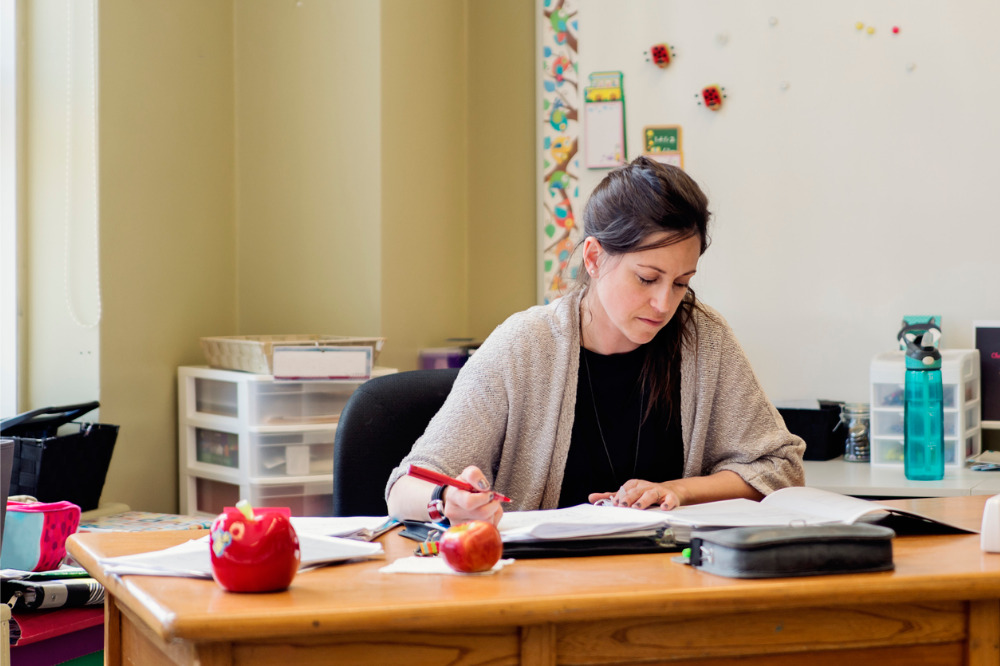
Even before the rapid shift to remote and online teaching, Australian schools were faced with numerous challenges.
Teachers were burdened by massive workloads and administration demands, declining perceptions of autonomy, and high rates of stress for both staff and students.
A recently released study from Macquarie University and the University of Wollongong is one of few to document the impacts, both positive and negative, from the perspective of Australian teachers.
“I miss seeing the kids!”: Australian teachers’ changing roles, preferences, and positive and negative experiences of remote teaching during the COVID 19 pandemic, by Professor Penny Van Bergen and Emily Daniel, explores teachers’ experiences during the implementation of remote and home-based learning during the first wave of COVID-19.
"Teachers’ perspectives on these changes are critical for two reasons. They are experts within education and can offer important insights for policy and practice and the heaviest burden of remote learning arrangements fell on teachers themselves,” Associate Professor Van Bergen said.
What the participants said
The study, which took place during the first COVID-19 wave, included 210 Australian teachers: 163 secondary teachers, 37 primary teachers, and 10 special education teachers.
Participants ranged in teaching experience and came from multiple Australian states and territories. There were 131 teachers employed in the public school system, 51 in the independent school system and 28 in the Catholic system.
“Teachers were asked two key questions: The first about how their day-today role as a teacher had changed due to COVID-19, and the second about their perceptions of the change to remote learning during COVID-19,” Associate Professor Van Bergen said.
According to the findings, participants reported missing their students and struggling with excessive workload demands. They also experienced difficulties tracking student progress and felt worried for student wellbeing. Interestingly, concerns about technology were less common with 19.1% enjoying learning new online skills and integrating IT in new ways.
“Teachers described comprehensive and multifaceted changes to their teaching activities including lesson design and materials, pedagogy, feedback, and assessment. Explicit in teachers’ responses was that the sheer volume of work was relentless and unsustainable, with negative impacts on family time and their own mental health,” Associate Professor Van Bergen said.
Fay (60, secondary teacher) commented, “Planning online learning materials is extensive and exhausting... requiring flexibility and innovation to present and deliver the learning materials in a way that is meaningful, relevant, and accessible to students. What digital platform to use? Can the students actually do those activities in their homes? Do they have access to the internet? Are they sharing devices with other family members? What resources do they have at home? How do you track what [they] are doing?”
Teachers’ working hours ballooned during Covid
As a consequence of the rapid shift to online and remote instruction, numerous teachers reported working extraordinarily long hours with insufficient preparation time.
Rowena (40, secondary teacher) suggested that COVID-19 had “extended my working days to 15 h or more” and Chantelle (55, secondary teacher) reported working “most days from 8:30am to well after 10:00 pm”. Bella (26, secondary teacher) stated that she was “expected to be online, not from 9 to 3 but 24 h a day” in order to “respond to students, parents, caregivers, and the school executive”.
The sharp increase in teachers’ workload had a negative impact. Sabine (42, secondary teacher) stated that her work had “[taken] away valuable family time”. According to Alina (33, secondary teacher), “The workload has increased even more than I thought possible. It’s soul destroying. And then when the technology keeps failing it’s hard not to cry”.
Participants most commonly reported they deeply missed their relationships with students (51.4%) and teaching face-to-face (45.7%). A sizeable number also reported being unable to track student learning (30.0%) and feeling worried about student learning and wellbeing (21.0%).
As 26-year-old primary teacher Rosie reported, “I miss my students—I became a teacher for them so feel disconnected from the job with them learning remotely”.
“Teaching is relational. It is live and requires human interaction. We are doing our utmost to replicate but it’s draining. I’m doing more for Year 12 than ever before - without the fun bits.” (Sahara, 47, secondary teacher)
Aneeka (40, primary teacher) stated that she ““miss[ed] the kids and being able to teach face to face”, while Lilia (37, secondary teacher) stated that she… “miss[ed] seeing students face to face and the wonderful and hilarious things they come up with… I also miss the challenge of getting to students who are struggling”
The takeaways for school leaders and policymakers
The study highlighted the importance of educational leaders, policymakers, and researchers understanding what teachers themselves consider as the biggest challenges in their roles when transitioning to remote learning.
As Associate Professor Van Bergen explains: “Such insights have implications for the future, with subsequent COVID-19 waves, climate change, and other natural disasters threatening to disrupt education indefinitely and with a changing, potentially blended landscape on the educational horizon.”
Associate Professor Van Bergen said the study’s findings suggest the strong need for accessible mental health services for teachers, for future pandemic planning that centralises at least some aspects of online lesson design and resource allocation, and for government communication which acknowledges the extraordinary contributions teachers have made across the life of the COVID-19 pandemic.
“Given the barrier that some teachers encountered when trying to check in on students who did not have sufficient technology access, we also highlight the need for national conversations about educational equity and the provision of learning resources at home.”
The original version of this article appeared as a media release from MCERA.


